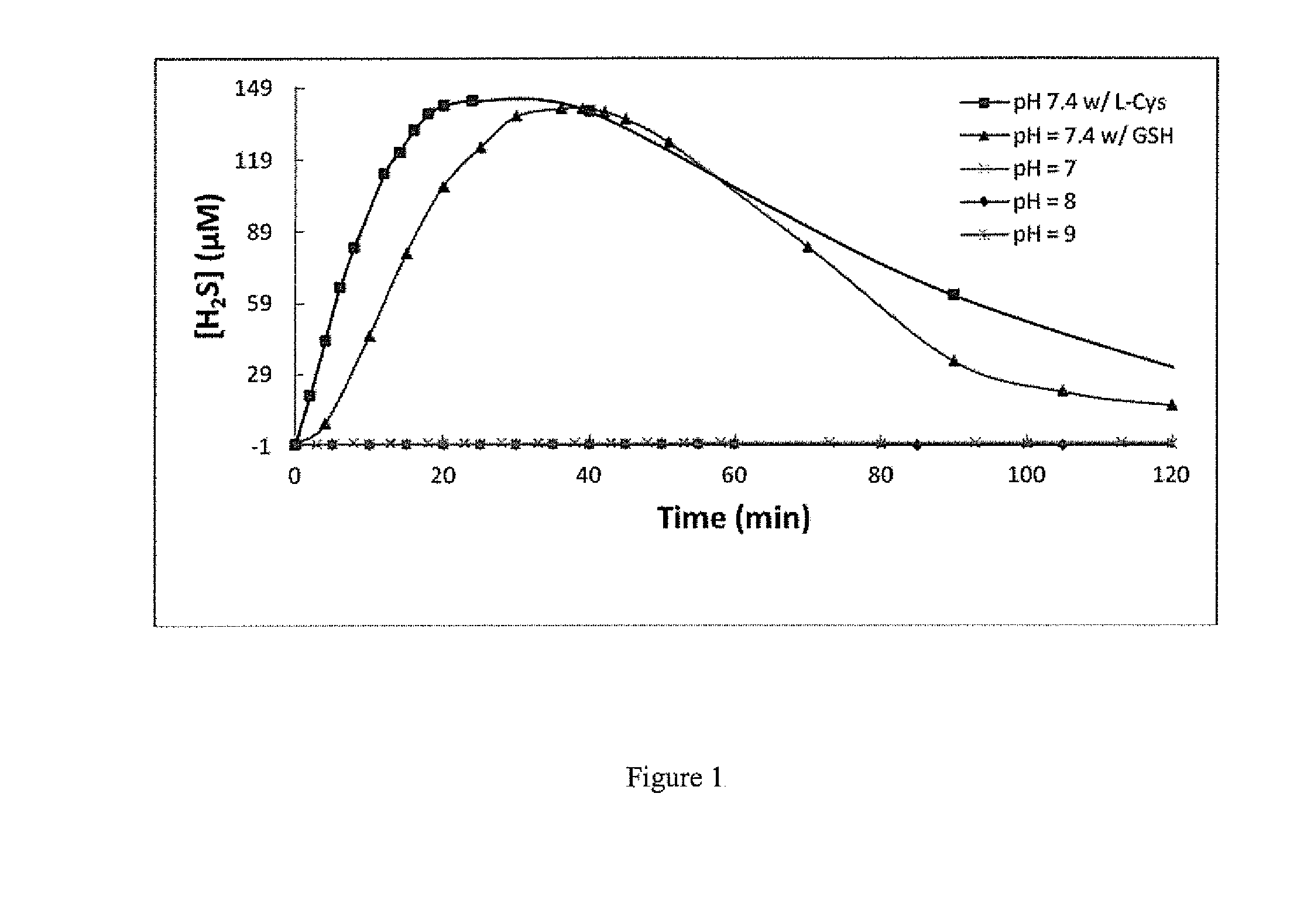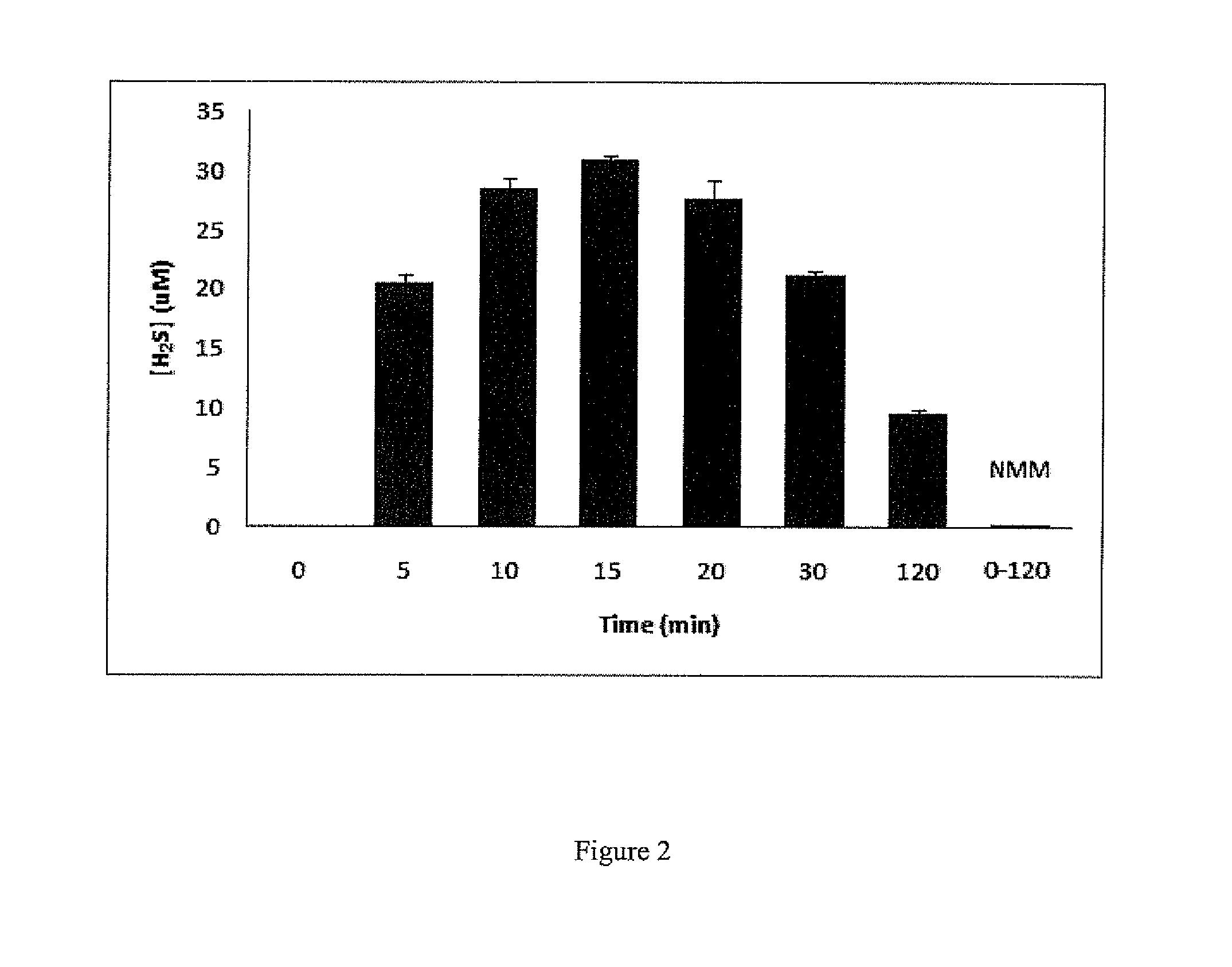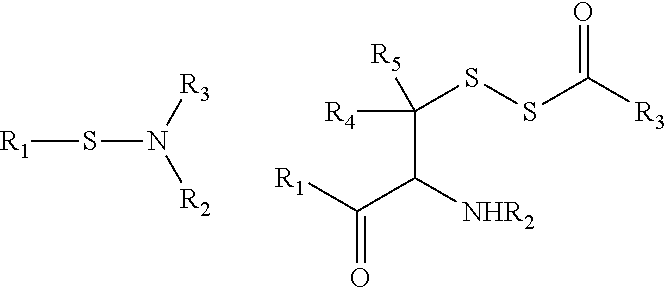Controlled chemical release of hydrogen sulfide
a hydrogen sulfide and chemical technology, applied in the direction of biocide, cardiovascular disorder, drug composition, etc., can solve the problems of limited hsub>2/sub>s gas therapy potential, dramatic affect, and limited current available hsub>2/sub>s donors
- Summary
- Abstract
- Description
- Claims
- Application Information
AI Technical Summary
Benefits of technology
Problems solved by technology
Method used
Image
Examples
example 1
Synthesis
[0076]
[0077]To a stirred solution of KOH (560 mg, 10 mmol) in water (15 mL) was added thiobenzoic acid (690 mg, 5 mmol) and hydroxylamine-O-sulfonic acid (565 mg, 5 mmol). The solution was stirred for 20 min at rt. The white solid (S-benzoylthiohydroxylamine) was collected by filtration and then dissolved in CH2Cl2 (10 mL). To this mixture was added benzoic anhydride (2.26 g, 10 mmol). The resulting solution was allowed to stir overnight at rt. The crude product was purified by recrystallization (CH2Cl2 / hexane) to give 2 as white solid. m.p. 138-140° C.; 1H NMR (300 MHz, CDCl3) δ 7.92 (m, 4H), 7.60 (m, 1H), 7.53 (m, 1H), 7.39 (m, 4H), 7.17 (s, 1H); 13C NMR (75 MHz, CDCl3) δ 190.0, 159.1, 134.6, 134.4, 133.3, 132.8, 129.3, 129.0, 128.0, 127.3; IR (thin film) cm−1 3265, 3062, 1696, 1659, 1451, 1419, 1257, 1207; HRMS m / z 258.0598 [M+H]+; calcd for C14H12NO2S 258.0589; overall yield: 64% (2 steps).
[0078]3 was prepared from p-fluorothiobenzoic acid using the same procedure as 2....
example 2
Methylene Blue Experiment for H2S Release in PBS Buffer
Na2S Standard Curve for H2S Release
[0111]2.0 mM Na2S stock solution was prepared as described in previous section. Five aliquots of Na2S solution at 3.75 μL, 7.50 μL, 15.0 μL, 45.0 μL, and 112.5 μl were injected into the 4-mL vials containing H2O (1.0 mL), zinc acetate (1% w / v, 100 μL), N,N-dimethyl-1,4-phenylenediamine sulfate (200 μL, 20 mM) in 7.2 M HCl and ferric chloride (200 μL, 30 mM) in 1.2 M HCl, respectively. Stir the resultant solution for 15 minutes at room temperature. The absorbance (670 nm) of aliquots was determined using a UV-Vis spectrometer.
H2S Release in PBS Buffer
[0112]Cysteine stock solution in H2O (400 mM, 112.5 μL) and N-(benzoylthio)benzamide 2 stock solution in THF (40 mM, 112.5 μL) were added into PBS buffer solution (30 mL, pH=7.4) containing EDTA (50 mM, 60 μL), respectively. Every 3 minute, 1.0 mL of aliquots were taken to 4-mL vials containing, zinc acetate (1% w / v, 100 μL), N,N-dimethyl-1,4-phenyl...
example 3
H2S Release Measurement in Plasma
[0114]It is known that plasma contains significant amount of free cysteine. We therefore measured H2S generation of 2-13 in plasma (containing ˜500 μM cysteine) using a colorimetry method. We observed a similar time-dependent H2S release (FIG. 2, illustrated an example using 2) as the one shown in FIG. 18. However, when plasma was first treated with N-methylmaleimide (NMM) to block free cysteine, no H2S generation was observed. These results demonstrated the capability of H2S release from N-(benzoylthio)benzamide-based donors in complex biological systems. It is also demonstrated that cysteine is the regulator of this type of donors.
[0115]To 0.5 mL of bovine / calf plasma was added 0.5 mL water solution containing zinc acetate (1% w / v, 100 μL) and trichloroacetic acid (10% w / v, 600 μL). The mixture was allowed to centrifuge for 10 min (5000 g). The precipitate was filtered out and 1.2 mL of the clear solution was transferred ...
PUM
| Property | Measurement | Unit |
|---|---|---|
| Molar density | aaaaa | aaaaa |
| Molar density | aaaaa | aaaaa |
| Molar density | aaaaa | aaaaa |
Abstract
Description
Claims
Application Information
 Login to View More
Login to View More - R&D
- Intellectual Property
- Life Sciences
- Materials
- Tech Scout
- Unparalleled Data Quality
- Higher Quality Content
- 60% Fewer Hallucinations
Browse by: Latest US Patents, China's latest patents, Technical Efficacy Thesaurus, Application Domain, Technology Topic, Popular Technical Reports.
© 2025 PatSnap. All rights reserved.Legal|Privacy policy|Modern Slavery Act Transparency Statement|Sitemap|About US| Contact US: help@patsnap.com



